Virginia, a state in the eastern United States, has many lakes and reservoirs — and those lakes and reservoirs have snakes. A few lakes, in particular, offer a fascinating opportunity for nature enthusiasts to observe and appreciate the incredible diversity of snakes that inhabit the region.

From venomous species like the copperhead to harmless water snakes, Virginia’s lakes provide a unique glimpse into the intriguing world of these scaly reptiles. So, if you’re an adventurous soul seeking a captivating wildlife experience, don’t miss the chance to explore three of the most snake-infested lakes in Virginia! Now, that doesn’t mean that these lakes are full to the brim with snakes, only that they contain the highest number of snakes compared to other lakes in Virginia. The lakes covered in this article include:
1. Lake Gaston
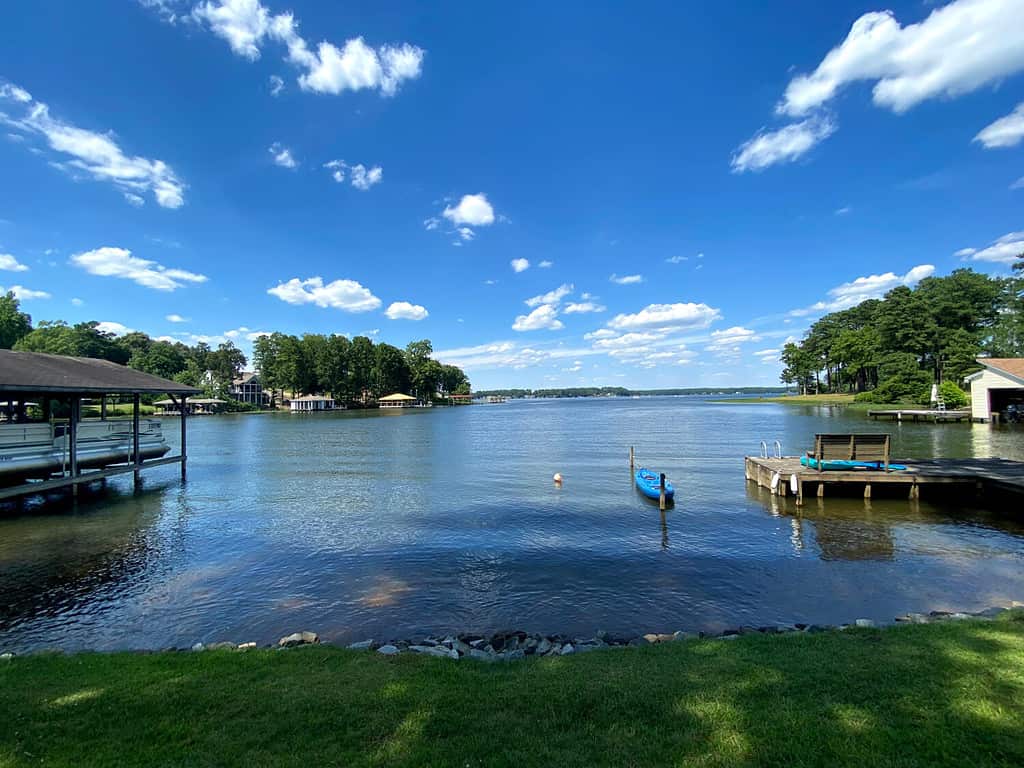
Lake Gaston is one of the most snake-infested lakes in the
United States
.
©KHilliard/Shutterstock.com
Nestled on the Virginia-North Carolina border, Lake Gaston is renowned for its serene beauty. Anglers flock to this enticing reservoir, captivated by the bountiful largemouth bass, striped bass, and catfish. Indulge in swimming, boating, and camping, and immerse yourself in the charming embrace of Lake Gaston. However, amidst its picturesque allure, caution must be taken as it is also the habitat of venomous snakes.
The most common venomous snakes you might encounter at Lake Gaston are the copperhead and the cottonmouth. Virginia’s other venomous snake, the timber rattlesnake, typically lives in rocky habitats. However, while the copperhead is the most numerous, it is also the least venomous of the three. In addition, these snakes are not typically aggressive, and only attack if stepped on, harassed, or threatened.
As per the Virginia Department of Game and Inland Fisheries, Lake Gaston typically holds the unfortunate title for the highest number of reported snake bites in the state. This can be attributed to the presence of multiple venomous snake species in the vicinity of the lake, coupled with its popularity as a swimming and boating spot.
2. Smith Mountain Lake
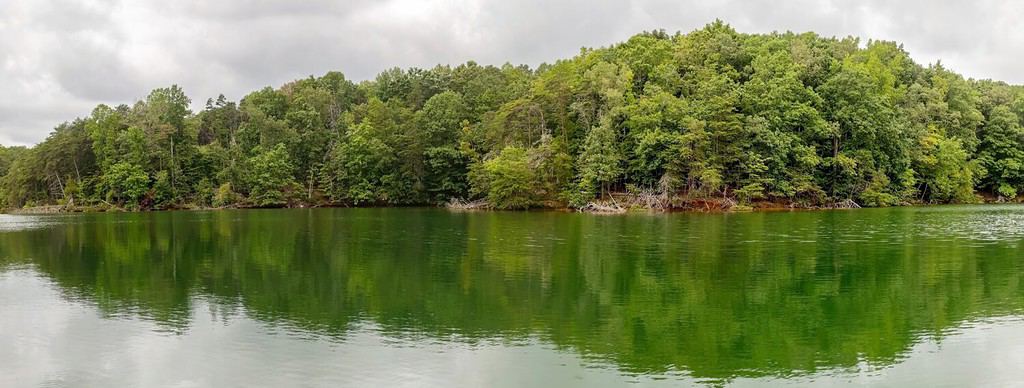
Smith Mountain Lake is large and full of many different types of snakes. However, most snakes here are not dangerous to humans.
©Noel V. Baebler/Shutterstock.com
Situated in the Roanoke Region of Virginia, United States, Smith Mountain Lake is a sprawling reservoir that rests southeast of the City of Roanoke and southwest of Lynchburg. This expansive body of water was formed in 1963 when the Smith Mountain Dam impounded the Roanoke River, resulting in a haven of natural beauty and tranquility.
Smith Mountain Lake, the second largest lake in Virginia, encompasses a stunning expanse of 32 square miles and boasts an impressive 500 miles of picturesque shoreline. With its abundant opportunities for boating, fishing, swimming, and water skiing, it has become a favored destination for outdoor enthusiasts. Adding to its allure, the lake is a serene habitat for a diverse array of wildlife, including graceful deer, majestic turkey, and even elusive black bears.
Smith Mountain Lake is also rich in snake diversity, housing numerous species such as the northern water snake, eastern ribbonsnake, black rat snake, and impressive eastern hognose snake, to mention but a few. Although these snakes can bite, they are not as dangerous as the three venomous snakes in Virginia. However, the copperhead and cottonmouth snakes often live around Smith Mountain Lake, so you should always check the area to make sure it’s safe to spend time in.
3. Lake Anna
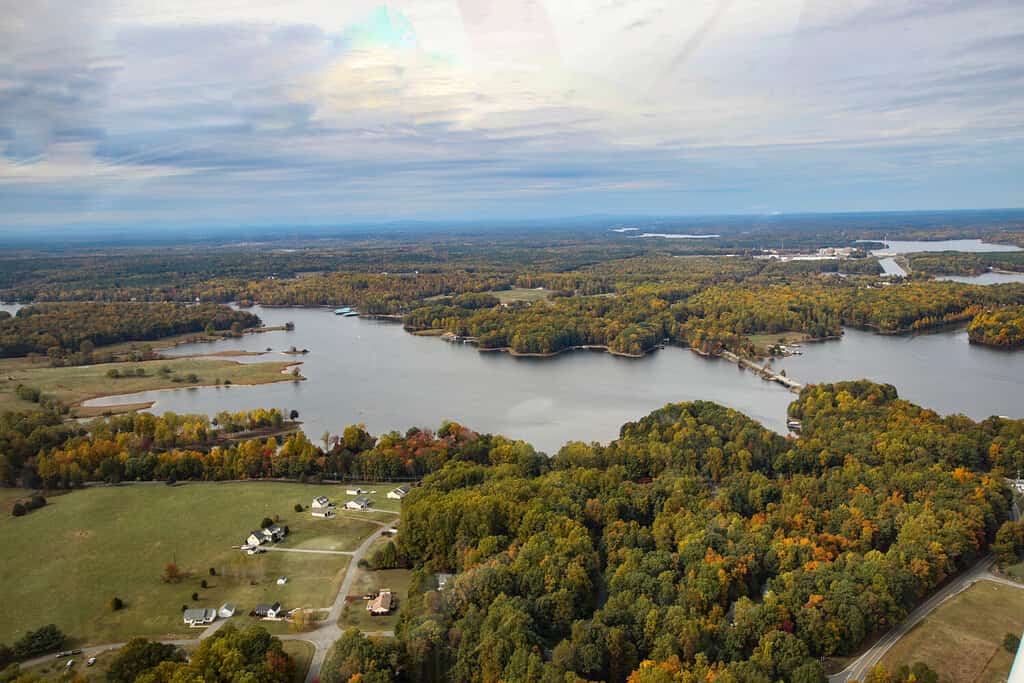
The only venomous snake that lives near Lake Anna is the copperhead.
©ButtermilkgirlVirginia/Shutterstock.com
Situated in central Virginia, Lake Anna is a captivating reservoir hosting a diverse array of snake species, such as the elusive copperhead, the agile northern water snake, and the remarkable eastern rat snake. Lake Anna is a great place for snake lovers to observe these creatures in their natural environment. Whether you’re an experienced herpetologist or just someone who enjoys watching wildlife, Lake Anna has something for everyone.
The only venomous snake you’ll encounter at Lake Anna is the copperhead. However, these snakes aren’t fond of water, but they do like warm stone areas, so it’s important to watch your step. The majority of copperhead snake bites around Lake Anna occur with curious dogs, so be sure to keep a close eye on your pup when they are exploring around the lake.
If you see a large snake in the water, it is most likely a water snake rather than a venomous snake. Water snakes are not friendly and can be quite aggressive, but they are not venomous. You should still stay away from them, however, as they are known to bite repeatedly.
How to Minimize the Risk of Snakebites in Virginia
When exploring Virginia’s lakes, it’s important to be aware of the potential risk of snakebites. If you happen to encounter a snake, maintain a safe distance and avoid any contact. Here are some other ways to stay safe while visiting the most snake-infested lakes in Virginia:
- When hiking or fishing near water, wear boots and long pants.
- Before settling down or stepping into any area, it is crucial to stay vigilant and carefully scan your surroundings for the presence of snakes.
- It is advisable to avoid handling snakes, even if they seem lifeless.
- When encountering a snake, it is best to refrain from attempting to harm it. Following these practices will help minimize the risk of snakebites.
- If someone gets bitten by a snake (which we hope never happens), it’s crucial to seek immediate medical help without delay, especially if it is a venomous snake.
Venomous Snakes Living Around the Most Snake-Infested Lakes in Virginia
The Copperhead Snake
The most common venomous snake you could encounter around Virginia’s snake-infested lakes is the copperhead snake (Agkistrodon contortrix), a venomous pit viper that inhabits various regions of Virginia. This particular serpent holds the distinction of being the most frequently encountered venomous snake in the state, accounting for the majority of snakebites. Copperheads live in a variety of habitats, including forests, fields, and near water. They are active during the day and night and are ambush predators.
Copperheads are medium-sized snakes and usually measure between 2 to 3 feet long. With their copper-colored heads and distinguishable hourglass pattern adorning their backs, these serpents present elegance. Underneath, their cream or yellow bellies exhibit captivating black spots.
Copperheads are not aggressive snakes and will only bite if they feel threatened. However, their bite can be dangerous and can cause severe pain, swelling, and bruising. In rare cases, a copperhead bite can be fatal. If you see a copperhead snake, it is important to give it plenty of space. Do not try to handle or kill the snake. If you are bitten by a copperhead, seek medical attention immediately. And always be sure to keep your dog away from piles of debris, as they might disturb a sleeping copperhead!

Northern copperhead snakes are one of North America’s most common species of venomous snakes. They possess some incredible camouflage that makes them seem almost invisible on the forest floor.
©JacobLoyacano/Shutterstock.com
The Cottonmouth Snake
The cottonmouth snake (Agkistrodon piscivorus) is a venomous pit viper found in the southeastern corner of Virginia, especially in wetland areas. These snakes love areas with water, like streams, swamps, lakes, ponds, and rivers. However, they only live in the southeastern corner of the state, so you likely won’t encounter one while visiting the three most snake-infested lakes in Virginia.
Cottonmouths, large and stout snakes, typically measure between 2 to 4 feet long. Adorned with a triangular head, their bodies display a dark brown or black hue with light brown or cream crossbands. The underbelly showcases a contrasting white tone embellished with black spots.
Cottonmouths are generally non-aggressive snakes and typically bite only when they perceive a threat. However, it’s crucial to note that a cottonmouth’s bite can be quite perilous, resulting in severe pain, swelling, and bruising. In rare instances, a cottonmouth bite can even be fatal. If you happen upon a cottonmouth snake, it is of utmost importance to provide it with ample space. It is strongly advised not to attempt handling or harming the snake. If you are bitten by a cottonmouth, seek immediate medical attention without delay.

When cottonmouth snakes swim, their bodies float on the surface of the water.
©Rafael R Sandoval/Shutterstock.com
The Timber Rattlesnake
The timber rattlesnake (Crotalus horridus) is another venomous pit viper that inhabits the mountainous regions of western Virginia, as well as a small area of extreme southeastern Virginia, where it is referred to as the canebrake rattlesnake. Boasting an impressive length ranging from 3 to 5 feet, it rightfully claims the title of Virginia’s largest venomous snake.
The timber rattlesnake boasts a distinctive triangular head and a body adorned with brown or gray hues, with a stunning array of dark brown or black bands. Its belly side is a lovely cream or yellow shade with elegant black spots. Notably, the tail culminates in a rattle composed of segments that grow incrementally with each shed.
Timber rattlesnakes inhabit diverse habitats, ranging from forests and meadows to rocky slopes. Fortunately, these snakes do not typically live in or around lakes in Virginia. Timber rattlesnakes are shy and generally non-aggressive creatures, only resorting to biting when they perceive a threat. Most timber rattlesnakes would much prefer to hide or run away rather than attack. However, it’s worth noting that their bite, though infrequent, can result in substantial discomfort, swelling, and bruising. In rare instances, a bite from a timber rattlesnake can even prove fatal.
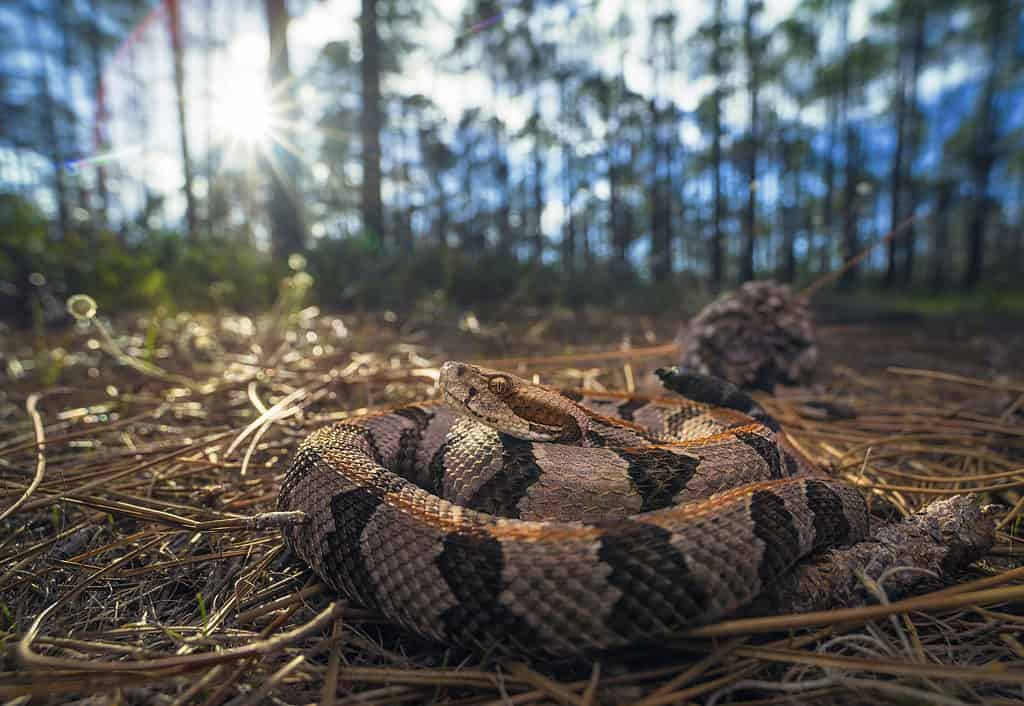
Timber rattlesnakes are shy and elusive, and do not typically live around lakes. They prefer forested or rocky areas.
©Kristian Bell/Shutterstock.com
Other Snakes Living Around the Most Snake-Infested Lakes in Virginia
Northern Watersnake
There are three different species of water snakes, found throughout the state of Virginia: the brown watersnake (Nerodia taxispilota), the plain-bellied watersnake (Nerodia erythrogaster), and the northern watersnake (Nerodia sipidon). They live in watery habitats like streams, lakes, rivers, reservoirs, backyard ponds, and ditches.
However, the most commonly encountered watersnake in Virginia is the northern watersnake. This snake is also commonly mistaken for a cottonmouth. Northern watersnakes have bodies that are brown to gray with white, yellow, and red coloring. They have large, heavy bodies that can grow up to 6 feet long with crossbands or blotches on their backs. Northern watersnakes swim with their body just below the surface of the water, whereas cottonmouths float along the surface of the water.
It can be pretty shocking to come across a watersnake in Virginia, but they are nonvenomous. However, they can be aggressive and bite repeatedly, so you should stay away from them as much as possible. Unfortunately, watersnakes like to bask on try branches above the water and have been known to fall into fishing boats. If this happens to you, try to stay calm and let the snake make its way back into the water.

Northern watersnakes are large and may look similar to other venomous snakes in Virginia.
©jmarino/Shutterstock.com
Eastern Hognose Snake
The eastern hognose snake (Heterodon platirhinos) is non-venomous in Virginia. It is a stout-bodied snake with a short tail, typically ranging from 20 to 33 inches in length. The head is large and triangular, with a distinctive upturned snout. The color of the eastern hognose snake varies, but it is typically brown, gray, or black with a cream or yellow belly.
The eastern hognose snake is harmless, but it has several defensive behaviors that can make it appear dangerous. If threatened, the eastern hognose snake may flatten its neck and hiss like a cobra. It may also feign death by rolling onto its back and opening its mouth. If these behaviors do not deter the threat, the eastern hognose snake may bite. However, its bite is not venomous to humans.
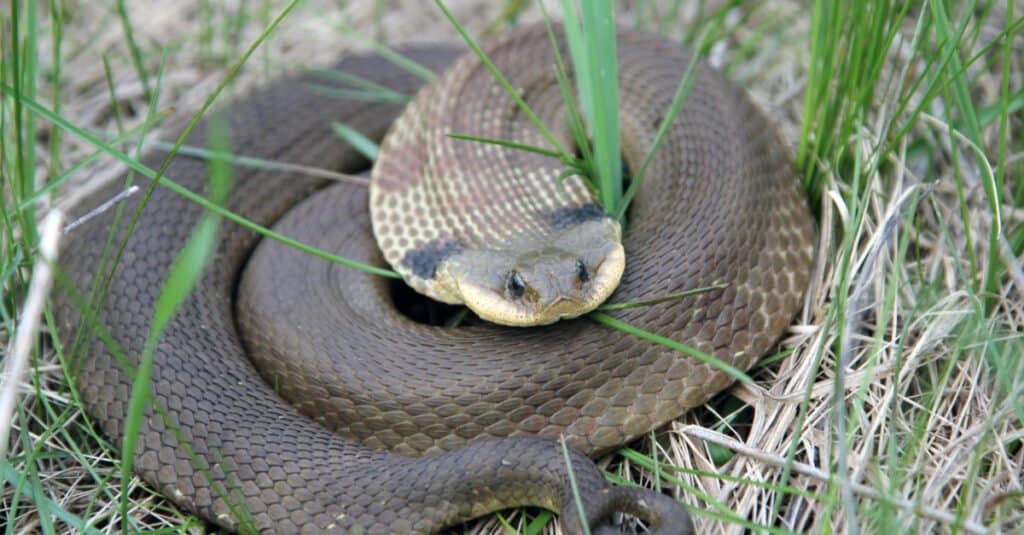
Hognose snakes are known for eating toads.
©iStock.com/deepspacedave
The Eastern Ribbonsnake
The eastern ribbonsnake (Thamnophis saurita) is a sleek and slender serpent adorned with a lengthy tail, typically measuring between 18 and 26 inches. It inhabits the eastern regions of North America, spanning from New England down to Florida and extending westward to the Great Lakes. Within Virginia, this species thrives in diverse habitats, encompassing lush forests, picturesque meadows, and serenading swamps.
The eastern ribbonsnake, adorned with three vibrant yellow to cream stripes gracefully adorning its back and sides, captivates with its exquisite beauty. Its head, a rich shade of brown, is complemented by striking white lips and underside. The eastern ribbonsnake is a harmless snake that preys on small amphibians, lizards, and rodents.
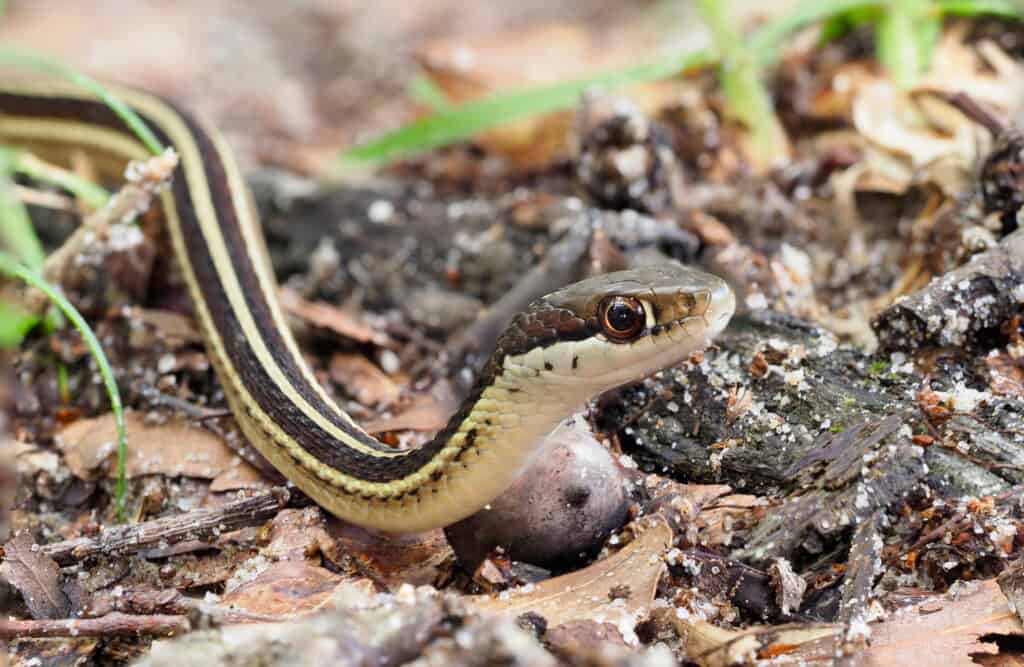
The eastern ribbonsnake is unique as a viviparous species, where the offspring develop within the mother’s body and are later birthed alive!
©Steve Bower/Shutterstock.com
The Black Racer Snake
The black racer snake (Coluber constrictor) is non-venomous in North America and Central America. It is one of the most common snakes in the United States and can be found in various habitats, such as forests, fields, and wetlands. And just in case you might be wondering, Coluber constrictor is referring to a species of non-venomous snake in the family Colubridae.
Black racer snakes have a slim shape and are usually black with a white chin and throat. Young ones may have a gray body with reddish-brown blotches. They can reach lengths of up to 60 inches (152 cm), but their average size ranges from 20 to 56 inches (50-142 cm) as adults.
Black racer snakes are extremely quick; these snakes are frequently seen during the day, and they are great climbers who enjoy basking in the sun. They are not considered to be dangerous and are generally not aggressive, however (as with most snakes) they can bite if they feel threatened. So, if you see a black racer snake, be sure to admire it from a distance and let it go on its way.
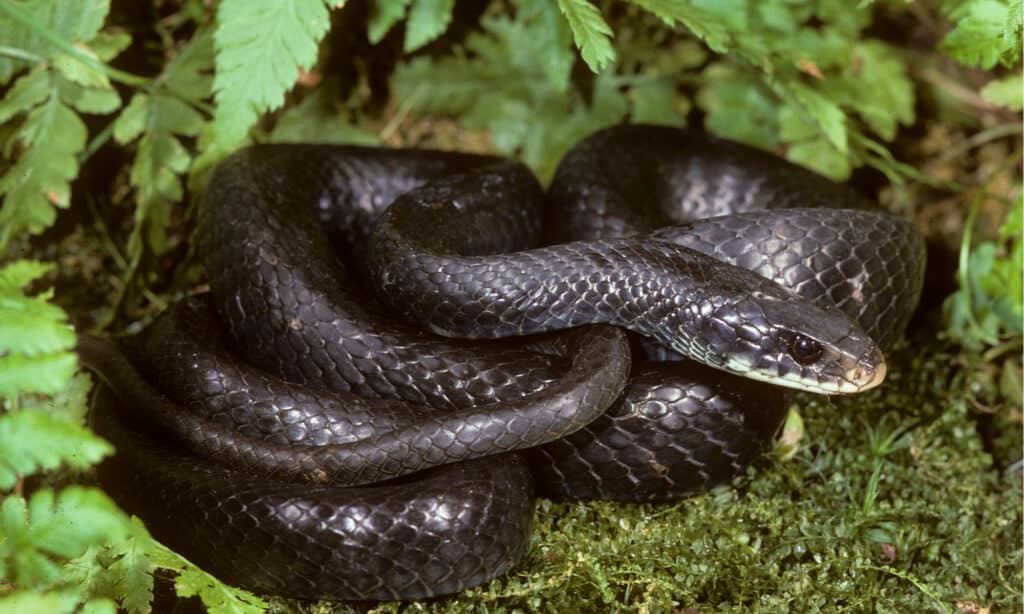
Northern black racers are quick-moving snakes.
©Breck P. Kent/Shutterstock.com
The Eastern Rat Snake
The eastern rat snake (Pantherophis alleghaniensis) is an impressive non-venomous serpent inhabiting various regions of the eastern United States, including Virginia. It claims the title of Virginia’s longest snake, often reaching lengths of up to 6 feet.
Eastern rat snakes possess exceptional climbing and swimming abilities. They exhibit remarkable swiftness, capable of reaching speeds of up to 10 miles per hour. These highly active reptiles prefer daylight hours and maintain a diverse diet, which includes small mammals, birds, and lizards.
Eastern rat snakes, though classified as non-dangerous, generally exhibit non-aggressive behavior. However, they may resort to biting when sensing a threat. These remarkable creatures play a crucial role in preserving ecosystem equilibrium by effectively regulating populations of rodents and other pests.
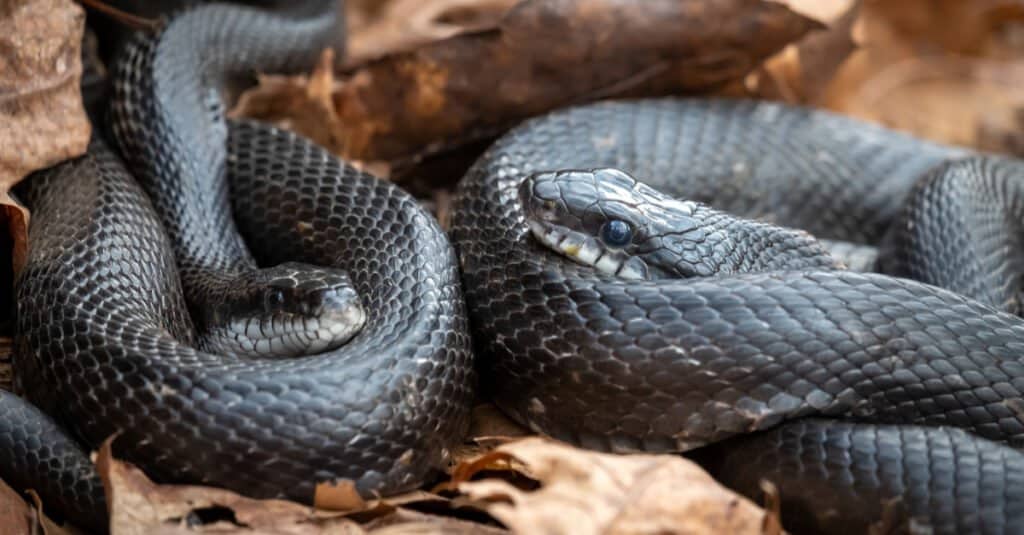
The base of the eastern rat snake’s body is typically shiny black.
©samray/Shutterstock.com
Summary of the 3 Most Snake-Infested Lakes in Virginia
| Infested Lake | Snakes | |
|---|---|---|
| 1 | Lake Gaston | Copperhead, Cottonmouth |
| 2 | Smith Mountain Lake | Northern water snake, eastern ribbonsnake, black rat snake, and eastern hognose snake |
| 3 | Lake Anna | Copperhead, northern water snake, and eastern rat snake |
The photo featured at the top of this post is © Erin HG/Shutterstock.com
Thank you for reading! Have some feedback for us? Contact the AZ Animals editorial team.







